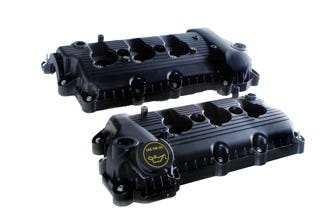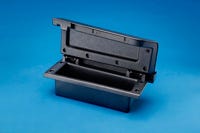Wheat straw and reclaimed carpet; Ford seeks greener paths to components
In two announcements this week, automotive OEM Ford Motor Co. showed progress in its efforts to build a "sustainable materials portfolio," offering details on cylinder head covers made from post-consumer nylon that was most recently carpet, and storage bins that use wheat straw to fortify polyropylene (PP).
January 12, 2010
In two announcements this week, automotive OEM Ford Motor Co. showed progress in its efforts to build a "sustainable materials portfolio," offering details on cylinder head covers made from post-consumer nylon that was most recently carpet, and storage bins that use wheat straw to fortify polyropylene (PP).
|
Automotive supplier Dana Holding Corp. (Maumee, OH) is molding the reclaimed nylon into cylinder-head covers for Ford's 3.0-liter Duratec engine, which is used in the 2010 Fusion and Escape. Called EcoLon, the nylon was created in conjunction with compounder Wellman Engineering Resins (Johnsonville, SC), which helped Dana test, develop, and supply the material. Wellman grinds used nylon carpeting into fiber and takes it back to its resin stage through a proprietary process.
In addition to resource reuse, the components boost Ford's green cred through weight, and thereby, fuel savings. The nylon cylinder-head covers are nearly 20% lighter than aluminum die-cast versions. The components are part of a module-based sealing system Dana supplies for the Ford Fusion and Escape programs that also includes the engine cover, gaskets, fasteners, baffle/air-oil separator, and isolators. Dana developed, tested, and is manufacturing the cylinder head covers at its Composite Sealing Center in Paris, TN.
Ford applies post-consumer recycled resins from sources as disparate as detergent bottles, tires, and battery casings in a variety of components, including aerodynamic, splash, and radiator air-deflector shields. Through these efforts, it estimates that between 25 and 30 million lb of plastic are diverted from landfills.
|
The third-row storage bins of the 2010 Ford Flex utilize a 20% wheat-straw-filled polypropylene, with the biomass increasing flexural modulus with a limited addition to part mass. |
The wheat-straw-reinforced third-row storage bins of the 2010 Ford Flex were developed by the automaker, academic researchers, and compounder A. Schulman (Akron, OH). The composite material contains 20% wheat straw bio-filler, which reportedly allows the application to conserve 20,000 lb/yr of petroleum by displacing plastic, while reducing annual carbon dioxide emissions by 30,000 lb. Ellen Lee, technical expert, in Ford's plastics research group, told Plastics Today that the natural fiber, which is supplied by Canadian firm Omtec (Mississaugua, ON), is mixed with PP. The wheat straw composite was originally proposed to Ford by University of Waterloo in Ontario, as part of the Ontario BioCar Initiative, a multi-university effort among the universities of Waterloo, Guelph, Toronto, and Windsor. Lee said Omtec's proprietary process cleans, chops, and dries the wheat straw so that it can be compounded. The parts themselves are molded by International Automotive Components (IAC; Dearborn, MI).
A. Schulman's lab was used to create a composition that was not only odorless, but also met industry standards for thermal expansion and degradation, rigidity, moisture absorption, and fogging. Ford says that less than 18 months after the initial proposal was made to Ford's Biomaterials Group, the wheat straw-reinforced plastic was approved for the Flex, which is produced at Ford's Oakville (Ontario) assembly complex. As for feedstock supply, Ford says, wheat straw, which is the byproduct of growing and processing wheat, is typically discarded, with Ontario, for example, having 30 million tonnes available at any given time.
Lee says the company sees a great deal of potential for other applications utilizing the filler due to wheat straw's impact on mechanical properties, particularly its ability to offer a light weight means to greater stiffness. Utilization of the composite in center console bins and trays; interior air registers and door trim panel components; and armrest liners is already under consideration by Ford.
The automaker's sustainable materials portfolio also includes soy-based polyurethane seat cushions, seatbacks and headliners; post-industrial recycled yarns for seat fabrics; and post-consumer recycled resins for underbody systems. —Tony Deligio
About the Author(s)
You May Also Like




